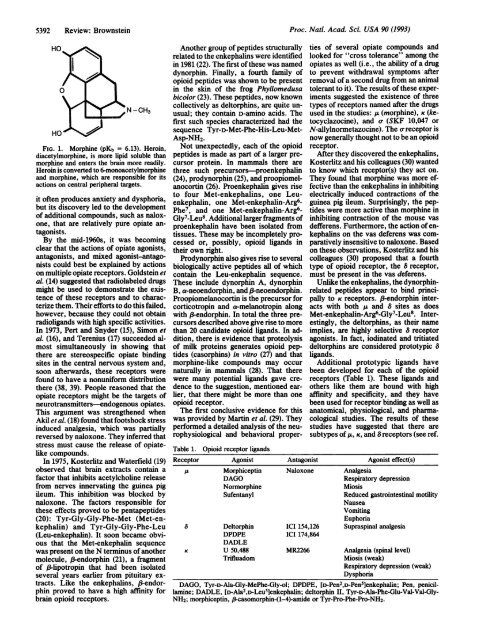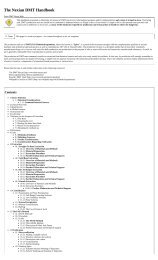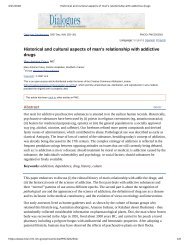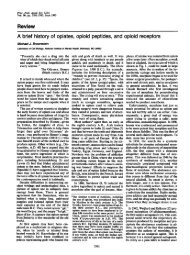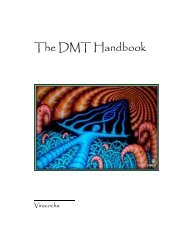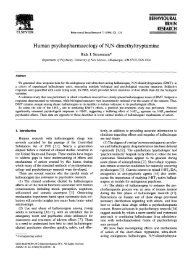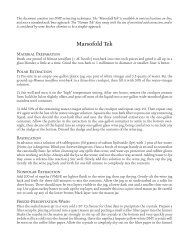pnas01469-0022
pnas01469-0022
pnas01469-0022
Create successful ePaper yourself
Turn your PDF publications into a flip-book with our unique Google optimized e-Paper software.
5392 Review: Brownstein<br />
HO<br />
HO<br />
0<br />
N -CH3<br />
FIG. 1. Morphine (pKb = 6.13). Heroin,<br />
diacetylmorphine, is more lipid soluble than<br />
morphine and enters the brain more readily.<br />
Heroin is converted to 6-monoacetylmorphine<br />
and morphine, which are responsible for its<br />
actions on central peripheral targets.<br />
it often produces anxiety and dysphoria,<br />
but its discovery led to the development<br />
of additional compounds, such as naloxone,<br />
that are relatively pure opiate antagonists.<br />
By the mid-1960s, it was becoming<br />
clear that the actions of opiate agonists,<br />
antagonists, and mixed agonist-antagonists<br />
could best be explained by actions<br />
on multiple opiate receptors. Goldstein et<br />
al. (14) suggested that radiolabeled drugs<br />
might be used to demonstrate the existence<br />
of these receptors and to characterize<br />
them. Their efforts to do this failed,<br />
however, because they could not obtain<br />
radioligands with high specific activities.<br />
In 1973, Pert and Snyder (15), Simon et<br />
al. (16), and Terenius (17) succeeded almost<br />
simultaneously in showing that<br />
there are stereospecific opiate binding<br />
sites in the central nervous system and,<br />
soon afterwards, these receptors were<br />
found to have a nonuniform distribution<br />
there (38, 39). People reasoned that the<br />
opiate receptors might be the targets of<br />
neurotransmitters-endogenous opiates.<br />
This argument was strengthened when<br />
Akil et al. (18) found that footshock stress<br />
induced analgesia, which was partially<br />
reversed by naloxone. They inferred that<br />
stress must cause the release of opiatelike<br />
compounds.<br />
In 1975, Kosterlitz and Waterfield (19)<br />
observed that brain extracts contain a<br />
factor that inhibits acetylcholine release<br />
from nerves innervating the guinea pig<br />
ileum. This inhibition was blocked by<br />
naloxone. The factors responsible for<br />
these effects proved to be pentapeptides<br />
(20): Tyr-Gly-Gly-Phe-Met (Met-enkephalin)<br />
and Tyr-Gly-Gly-Phe-Leu<br />
(Leu-enkephalin). It soon became obvious<br />
that the Met-enkephalin sequence<br />
was present on the N terminus of another<br />
molecule, ,B-endorphin (21), a fragment<br />
of ,-lipotropin that had been isolated<br />
several years earlier from pituitary extracts.<br />
Like the enkephalins, (-endorphin<br />
proved to have a high affinity for<br />
brain opioid receptors.<br />
Another group of peptides structurally<br />
related to the enkephalins were identified<br />
in 1981 (22). The first of these was named<br />
dynorphin. Finally, a fourth family of<br />
opioid peptides was shown to be present<br />
in the skin of the frog Phyllomedusa<br />
bicolor (23). These peptides, now known<br />
collectively as deltorphins, are quite unusual;<br />
they contain D-amino acids. The<br />
first such species characterized had the<br />
sequence Tyr-D-Met-Phe-His-Leu-Met-<br />
Asp-NH2.<br />
Not unexpectedly, each of the opioid<br />
peptides is made as part of a larger precursor<br />
protein. In mammals there are<br />
three such precursors-proenkephalin<br />
(24), prodynorphin (25), and proopiomelanocortin<br />
(26). Proenkephalin gives rise<br />
to four Met-enkephalins, one Leuenkephalin,<br />
one Met-enkephalin-Arg6-<br />
Phe7, and one Met-enkephalin-Arg6-<br />
Gly7-Leu8. Additional larger fragments of<br />
proenkephalin have been isolated from<br />
tissues. These may be incompletely processed<br />
or, possibly, opioid ligands in<br />
their own right.<br />
Prodynorphin also gives rise to several<br />
biologically active peptides all of which<br />
contain the Leu-enkephalin sequence.<br />
These include dynorphin A, dynorphin<br />
B, a-neoendorphin, and 3-neoendorphin.<br />
Proopiomelanocortin is the precursor for<br />
corticotropin and a-melanotropin along<br />
with l3-endorphin. In total the three precursors<br />
described above give rise to more<br />
than 20 candidate opioid ligands. In addition,<br />
there is evidence that proteolysis<br />
of milk proteins generates opioid peptides<br />
(casorphins) in vitro (27) and that<br />
morphine-like compounds may occur<br />
naturally in mammals (28). That there<br />
were many potential ligands gave credence<br />
to the suggestion, mentioned ear-<br />
Proc. Natl. Acad. Sci. USA 90 (1993)<br />
lier, that there might be more than one<br />
opioid receptor.<br />
The first conclusive evidence for this<br />
was provided by Martin et al. (29). They<br />
performed a detailed analysis of the neurophysiological<br />
and behavioral properties<br />
of several opiate compounds and<br />
looked for "cross tolerance" among the<br />
opiates as well (i.e., the ability of a drug<br />
to prevent withdrawal symptoms -after<br />
removal of a second drug from an animal<br />
tolerant to it). The results of these experiments<br />
suggested the existence of three<br />
types of receptors named after the drugs<br />
used in the studies: ,u (morphine), K (ketocyclazocine),<br />
and oa (SKF 10,047 or<br />
N-allylnormetazocine). The crreceptor is<br />
now generally thought not to be an opioid<br />
receptor.<br />
After they discovered the enkephalins,<br />
Kosterlitz and his colleagues (30) wanted<br />
to know which receptor(s) they act on.<br />
They found that morphine was more effective<br />
than the enkephalins in inhibiting<br />
electrically induced contractions of the<br />
guinea pig ileum. Surprisingly, the peptides<br />
were more active than morphine in<br />
inhibiting contraction of the mouse vas<br />
defferens. Furthermore, the action of enkephalins<br />
on the vas deferens was comparatively<br />
insensitive to naloxone. Based<br />
on these observations, Kosterlitz and his<br />
colleagues (30) proposed that a fourth<br />
type of opioid receptor, the 8 receptor,<br />
must be present in the vas deferens.<br />
Unlike the enkephalins, the dynorphinrelated<br />
peptides appear to bind principally<br />
to K receptors. ,B-endorphin interacts<br />
with both a and 8 sites as does<br />
Met-enkephalin-Arg6-Gly7-Leu8. Interestingly,<br />
the deltorphins, as their name<br />
implies, are highly selective a receptor<br />
agonists. In fact, iodinated and tritiated<br />
deltorphins are considered prototypic 8<br />
ligands.<br />
Additional prototypic ligands have<br />
been developed for each of the opioid<br />
receptors (Table 1). These ligands and<br />
others like them are bound with high<br />
affinity and specificity, and they have<br />
been used for receptor binding as well as<br />
anatomical, physiological, and pharmacological<br />
studies. The results of these<br />
studies have suggested that there are<br />
subtypes of IL, K, and 8 receptors (see ref.<br />
Table 1. Opioid receptor ligands<br />
Receptor Agonist Antagonist Agonist effect(s)<br />
,u4 Morphiceptin Naloxone Analgesia<br />
DAGO<br />
Respiratory depression<br />
Normorphine<br />
Miosis<br />
Sufentanyl<br />
Reduced gastrointestinal motility<br />
Nausea<br />
Vomiting<br />
Euphoria<br />
8 Deltorphin ICI 154,126 Supraspinal analgesia<br />
DPDPE ICI 174,864<br />
DADLE<br />
K U 50,488 MR2266 Analgesia (spinal level)<br />
Trifluadom<br />
Miosis (weak)<br />
Respiratory depression (weak)<br />
Dysphoria<br />
DAGO, Tyr-D-Ala-Gly-MePhe-Gly-ol; DPDPE, [D-Pen2,D-Pen5]enkephalin; Pen, penicillamine;<br />
DADLE, [D-Ala2,D-Leu5]enkephalin; deltorphin II, Tyr-D-Ala-Phe-Glu-Val-Val-Gly-<br />
NH2; morphiceptin, f3casomorphin-(1-4)-amide or Tyr-Pro-Phe-Pro-NH2.


